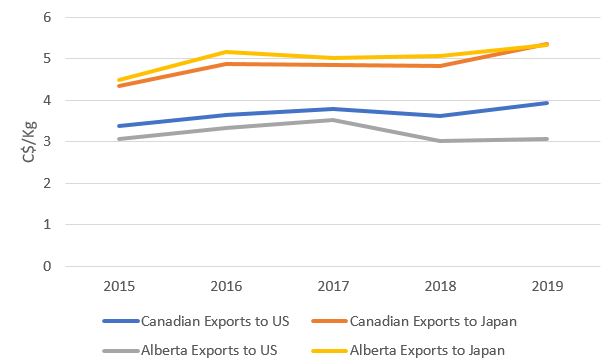By Jo-Ann McArthur
Editor’s note: Jo-Ann McArthur is the President and Founding Partner of Nourish, a marketing agency that specializes in field-to-fork food and beverage, working across all aspects of the food ecosystem. Clients include producers, processors, retailers, manufacturers, food service and restaurants. Jo-Ann can be contacted at j@nourish.marketing. Sign-up for the agency’s monthly newsletter at www.nourish.marketing.
I always like to say that Nourish is an agency that knows a lot about a little. We have the dual privileges of specializing in the food industry and working across its entire ecosystem. As a result, we are often able to connect dots that others may not.
We publish an annual Trend Report, now in its fourth year. And by trends, I mean cultural forces and shifts, not fads. Fads are like a one-time volcanic eruption: they are briefly hot before they cool and then disappear. Trends are the tectonic plates that move beneath us and reshape the landscape. New food systems, as well as product development, take time, so we need to make sure we are looking at a longer-term horizon.
When we look at trends, we are not passing judgement or making value statements. We are just reporting what we see coming. Looking back, we are happy to say that all the trends we have covered since 2017 are still actively reshaping the food industry and providing opportunities for producers, manufacturers, retailers and food service providers.
Here are some of the trends that could affect you most in 2020 – both positively and negatively.
Make way, Millennials: Gen Z is on the rise
In our 2019 Nourish Trend Report, we identified a shift from Millennials to Generation Z as one of the top eight trends to watch in the food industry. Gen Z members today are roughly between the ages of four- and 24-years-old. They comprise a quarter of the current population, which makes Gen Z more numerous than both Baby Boomers and Millennials. Over the next few years, that figure will balloon to 33 per cent.
Remarkably, while they are still establishing behaviours, even the youngest are already influencing their parents’ and grandparents’ buying decisions. What we are learning is that they are markedly different from previous generations, especially when it comes to the way they view meat.
Gen Z is engaged, aware and optimistic about their ability to effect change. Almost half of all surveyed said they believe they can make the world a better place. Importantly, they have grown up in a digital world where no question cannot be answered with their mobile device, so they expect radical transparency. And they want proof – a claim without evidence (or a picture) is just noise.
We call this “Made Matters.” It is shorthand for things consumers care about: quality, ingredients, health, animal welfare, environmental and labour concerns. They want to know how and where food was grown or raised. Both Gen Z and Millennials are more likely to purchase animal-welfare-certified products.
The “Eating Clean” definition is expanding to include not just what is in food but the entire journey, from how it was raised and by whom, to the treatment of workers, animals and the environment. All these factors are growing in importance and are top-of-mind with younger consumers.
Canadians have a lot to learn about farming

Unfortunately, while Canadian consumers trust Canadian farmers, they do not fully trust our food system. The Canadian Centre for Food Integrity’s 2019 Public Trust Research demonstrated a dangerous disconnect between consumer perception of the food system and reality that needs to be addressed. Consistent with last year’s data, it shows that only one in three Canadian consumers believes Canada’s food system is on the correct course. Fortunately, those who feel the food system is going in the right direction outnumber those who think it is headed down the wrong track.
The same research shows that 91 per cent of Canadians know little or nothing about modern farming practices, but 60 per cent of Canadians are interested in knowing more – a trend we reviewed in the 2020 Nourish Trend Report. The disparity between consumer beliefs and on-farm practices must be addressed. As insiders, you and I know Canadian agriculture has world-class standards, but consumers are less clear on that fact.
Eating meat is no longer a black-and-white issue
The number of Canadians who identify as vegan or vegetarian is on the rise. Still, 64 per cent of consumers said they had no issue consuming meat “if farm animals are treated decently and humanely.” Consumers are looking for reassurance about how the animals were treated, backed by audits and robust standards. Producers have an opportunity here to share their best practices and excellent records on animal welfare.
In the 2018 Nourish Trend Report, the rise of “plant-based” eating was one of the disruptive trends we shone a light on. More Canadians across cultures and generations are reducing their meat intake and adopting a flexitarian lifestyle to support animal welfare, the environment and their health – the top three reasons cited in a Dalhousie University study. People under the age of 35 are three times more likely to consider themselves vegetarians or vegans than people 49 or older.
In 2020, attitudes towards sustainable consumption are reaching a crucial tipping point away from aspiration and toward necessity. Research conducted with online Canadian members of the Angus Reid Forum (on behalf of The Meatless Farm), found that 77 per cent of consumers say they understand the damaging environmental impact of eating red meat, and 74 per cent believe it is important to reduce their carbon footprint. Yet, only 38 per cent of Canadians reduced their meat consumption to do so.
Will we see the emergence of a “climatarian” diet, where consumers start making food choices not based on food preferences or values but instead based on carbon footprint and environmental impact?
The plant-based trend is here, and it is not leaving

Blended or hybrid products (such as mixed plant and dairy, or plant and meat) are starting to emerge as an easier way for consumers to moderate their carbon footprint without giving up their preferred taste for animal products. Rather than doing flexitarian as an “either/or,” it can be done as an “and.” Blended protein is an old concept that recent economic prosperity has taken us away from. During the Second World War period, there were Victory posters in Canada about protein rationing. Boomers grew up with mothers who mixed ground meat with oats to make the grocery money extend further. What is old is new again!
In the U.S., Tyson Foods recently launched Raised & Rooted, a blended meat and pea-based protein, shortly after selling its share in Beyond Meat, a totally plant-based processed meat substitute. Perdue, a major chicken processing company, offers a Chicken Plus line of products combining chicken and vegetables.
These products leverage the technology necessary to make plant-based products stable but incorporate real meat to deliver the taste and texture consumers crave. Given that plant-based ingredients are in short supply, this may soon be the only way new players can enter the market while staying competitive.
In Canada, Maple Leaf Foods, shifted its vision to focus on becoming “the most sustainable protein company on Earth.” (Note the exclusion of the word “meat.”) It has positioned itself for the future by creating a separate plant-based division and building a $300 million facility in Indiana to support growth.
We have seen rapid changes in consumer behaviour with the COVID-19 crisis. Some of that behaviour will have a legacy effect on our food system. We have already seen a shift-in-stomach from food service to grocery as more people cook at home. Consumers will want to support their communities and neighbours, so we should also see an even more significant move to locally- and Canadian-grown food.























U.S. Hog Weights Continue to Baffle
Pork Commentary, June 1st, 2020
Jim Long, President-CEO, Genesus Inc.
Last week we observed that U.S. harvest weights were decreasing. This totally baffles us. There is no doubt the official USDA slaughter numbers have been significantly lower for the last six weeks compared to expectations or last year.
Last week we would have expected hog weights to hold or increase due to Monday being Memorial Day and Plants were closed. Instead, Tuesday-Wednesday-Thursday averaged 217.03 lb. carcass weight. The week before average was 217.20 lb. and a year ago 215.54 lbs. Three weeks ago U.S. lean hog weights were over 221 lbs.
It’s hard to believe hogs are backed up 5 million as some have stated. That is almost 3 weeks of U.S. weekly slaughter. Weight difference week over week and compared to last year don’t indicate anything close to this high a number.
In our opinion watch the next two weeks’ slaughter. We expect with current packer margins and plant productivity, weekly slaughters will be over 2.3 million head, watch the weights if they continue to decline it could be a strong indication that we are more current for various reasons (euthanization, non-major packer slaughter) then many expect. If so, we might get a nice bump in hog prices. We can hope.
Sow Slaughter
The latest weekly sow slaughter was 69,753 the week before over 70,000. Last year’s weekly sow slaughter averaged 57,500. From Dec 1st to Feb 29th the USDA Hogs and Pigs Report indicated the U.S. sow slaughter was 35,000 higher than a year ago. In March-April this year U.S. sow slaughter per week so far higher than March-April last year (up 36,000 total).
We sell breeding stock at Genesus. There is no doubt gilt sales have declined. Not only for us but for the whole genetic industry. Producers are protecting cash flow and concerned about the future. Lower replacements cut the breeding herd.
Our farmer arithmetic on this. Looking at breeding herd decline from Dec to June 1st (6 months).
Wherever it ends up there are fewer hogs coming and we expect breeding herd liquidation will not stop June 1st. Could end up with breeding herd down 500,000 before all the dust settles.
U.S. Pork Export
It’s not hard to imagine that U.S. Pork Exports would drop when hog slaughter numbers have declined significantly over the last six weeks. Less Pork – less to Export. Also, the huge jump in Pork cut-outs that got over $1.20 lb. would have foreign buyers to take pause.
The good news, it appears exports continue to run about 12-15,000 tonnes a week higher than a year ago (about 120-150,000 market hog equivalent). These types of numbers if they continue will support Pork cut-outs and hog prices as plants come into fuller harvest production.
Genesus and The National Hog Farmer collaborate annually to survey the Global Swine Industry. The result is the Global Mega Producer Report which identifies the companies with over 100,000 sows.
The 2020 list identifies 34 Global Mega Producers that together own more than 11.5 million sows, adding more than 2.5 million sows to global production. These companies are located in 9 different countries respectively.
Click below for the listing and brief description of each company.
GLOBAL MEGA PRODUCER LIST